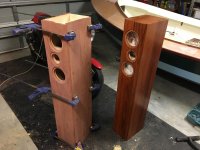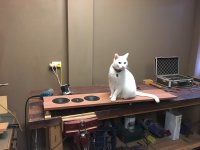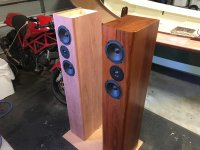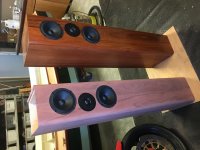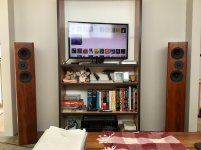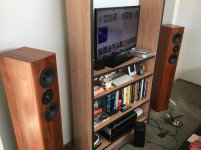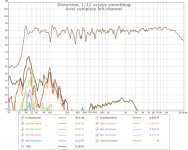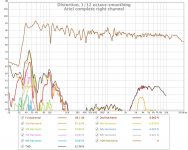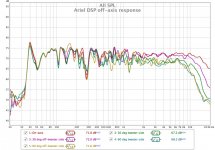Hey Graham,
Awesome to see you here. I played with the gating a bit (from default 4ms down to 1ms) but didn't see any noticeable change in the bottom end, which surprised me. I'm working in a very small (3m x4m) room, stuffed with sofa and Perry's DVDs.
I also played with moving the speaker around, pulling it away from the wall (the vent for the TL is at the bottom rear), but that also had no effect. I think to properly evaluate the bottom end I'd have to take it outside, but really what I'm interested in is how it works in this particular room, as that's where they'll be living.
Awesome to see you here. I played with the gating a bit (from default 4ms down to 1ms) but didn't see any noticeable change in the bottom end, which surprised me. I'm working in a very small (3m x4m) room, stuffed with sofa and Perry's DVDs.
I also played with moving the speaker around, pulling it away from the wall (the vent for the TL is at the bottom rear), but that also had no effect. I think to properly evaluate the bottom end I'd have to take it outside, but really what I'm interested in is how it works in this particular room, as that's where they'll be living.
Helping cat is helping
Here's a couple of photos to show how the second speaker is coming along. I haven't yet glued the component pieces together (sides, baffle, rear, interior) as I still need to do some routing so I can attach a top and bottom.
Our cat is always keen to check out whatever I'm doing in the garage.
The second one has come together more easily than the first. I've been keeping the sides clamped together when I'm not working on them to limit cupping. I'm off for work for a couple of weeks so I'll leave it clamped up like this while I'm away - that should ensure nothing goes out of whack.
Here's a couple of photos to show how the second speaker is coming along. I haven't yet glued the component pieces together (sides, baffle, rear, interior) as I still need to do some routing so I can attach a top and bottom.
Our cat is always keen to check out whatever I'm doing in the garage.
The second one has come together more easily than the first. I've been keeping the sides clamped together when I'm not working on them to limit cupping. I'm off for work for a couple of weeks so I'll leave it clamped up like this while I'm away - that should ensure nothing goes out of whack.
Attachments
Adding some tweeter delay helps immeasurably.
With 10us delay, 3.5KHz 18dB Butterworth filters, +2dB relative gain for the tweeter, and +6dB BSC (250Hz, Q=0.7) applied to the mid-woofers, I get the following plot. I've included a second plot to show the null from reversing phase on the tweeter.
Very nice!!! It helps to have drivers with flat responses, doesn't it?
What puzzles me is that these 25-year-old drivers have flatter responses than many contemporary drivers. Why? What are the guys at Tymphany thinking?
Apologies Suzy, I missed this post earlier.I played with the gating a bit (from default 4ms down to 1ms) but didn't see any noticeable change in the bottom end,
As I understand it, at 1-4ms gate width you won't be seeing any detail in the bottom end, so it's no surprise that you didn't see any differences. If I recall correctly REW shows what the frequency resolution is for the selected gating time. To get anything meaningful at the bottom end you'll need a hundred or so ms wide gate, and then an indoor measurement doesn't mean anything anyway because you're mostly measuring the interaction of the speaker and the room. So yes, as you say an outdoor measurement is called for. I think I know of some wide open, and quiet spaces near where you are🙂
I'm sure others here can correct me and/or explain this better than I can, but the above understanding fits with what I've learnt measuring speakers indoors.
Graham.
I do love the little Vifa pl13. It's a terribly easy driver to use. Initially I thought it'd be bass shy but the TL really takes care of that, at least at the listening levels that don't get me yelled at 🙂
I haven't committed to a crossover design yet. I think I'll do quite a bit more playing with the miniDSP first. I may even end up using that permanently, but I'll have to work out a way to put it in before the volume control. With it between the pre and power amp it's really quite crappy at low levels.
I haven't committed to a crossover design yet. I think I'll do quite a bit more playing with the miniDSP first. I may even end up using that permanently, but I'll have to work out a way to put it in before the volume control. With it between the pre and power amp it's really quite crappy at low levels.
So after a fortnight stuck in Sydney for work, where I got to listen to Grahams very cool Linkwitz open baffle monster speakers (watching the big 10" woofers go in and out was rather mesmerising), I spent the weekend pushing ahead on the second speaker.
Here 'tis, next to the other one for comparison. I'm approaching completion, at least from a woodworking perspective. Still some way to go with the amps.
Here 'tis, next to the other one for comparison. I'm approaching completion, at least from a woodworking perspective. Still some way to go with the amps.
Attachments
You have them reversed, tweeters go on the inside.
What's the rationale? The tweeter placement in my lounge room is deliberate. We're not able to put the speakers as far apart as we'd like, so I'm hoping that the diffraction from the outer edge will help provide a bit more tweeter level into the corners of the room.
Also I'm loving REW. I had a huge spike in distortion at 510Hz, which turned out to be a loose screw on one of the woofers. I'm not going to fix the buzzing at 30Hz though, as that's the windows rattling rather than the speakers 🙂
Last edited:
I think one of my tweeters might be a little stuffed.
Attached plots from each side, after a simple 18dB/octave 3.5KHz crossover, 120us of tweeter delay, and a little EQ applied at the bottom end for baffle step and to correct some room stuff.
The right side tweeter is down ~5dB wrt the left, and it has rather a lot more distortion. It's definitely the tweeter - when I mute the woofer it's exactly the same. Is this sort of variability from driver to driver typical?
Similarly I note the midrange distortion is higher for the left compared to the right, though this is at a much lower level.
Attached plots from each side, after a simple 18dB/octave 3.5KHz crossover, 120us of tweeter delay, and a little EQ applied at the bottom end for baffle step and to correct some room stuff.
The right side tweeter is down ~5dB wrt the left, and it has rather a lot more distortion. It's definitely the tweeter - when I mute the woofer it's exactly the same. Is this sort of variability from driver to driver typical?
Similarly I note the midrange distortion is higher for the left compared to the right, though this is at a much lower level.
Attachments
Usually SS drivers are very consistent. Check the Re of the tweeters with a DMM to see if there is a variation (should be about 4R7). Then try swapping over L>R, R>L. Check wiring polarity.
When installing these tweeters, tighten gradually in a X pattern and also check the screws on the faceplate.
When installing these tweeters, tighten gradually in a X pattern and also check the screws on the faceplate.
You have them reversed, tweeters go on the inside.
That's completely true for the original Ariel speakers. In the opposite direction, a dip at 3 kHz appears quite quickly off-axis. It is caused by baffle edge diffraction and loss of phase alignment as well.
What's the rationale? The tweeter placement in my lounge room is deliberate. We're not able to put the speakers as far apart as we'd like, so I'm hoping that the diffraction from the outer edge will help provide a bit more tweeter level into the corners of the room.
The Ariel, Part II
See section on "Speaker Location and Image Quality", since you have essentially built an Ariel speaker. It's not so much about getting tweeter level into the room, it's about imaging. Tweeter level is based on the series resistor in the crossover.
The Ariel, Part II
See section on "Speaker Location and Image Quality", since you have essentially built an Ariel speaker. It's not so much about getting tweeter level into the room, it's about imaging. Tweeter level is based on the series resistor in the crossover.
Not really. I've built an Ariel enclosure. The crossover is DSP. There is no series resistor on the tweeter. There's a 20uf cap in series, but that's simply there for protection if I stuff up the DSP settings. Also I'm driving the speakers with mosfet amps rather than valves.
So here's what happens off-axis.
For a listener in the corner of the room, they're most off-axis to the far-side speaker. So having that speaker provide less roll-off is good. This is the case with the off-tweeter side plots. 30 degrees on the off-tweeter side for the most distant speaker (corresponding pretty closely to where my sofa is in the lounge - see photo - The cat gets the prime spot in the middle) is almost as good as on-axis, thanks to diffraction.
So, tweeters on the outside.
For a listener in the corner of the room, they're most off-axis to the far-side speaker. So having that speaker provide less roll-off is good. This is the case with the off-tweeter side plots. 30 degrees on the off-tweeter side for the most distant speaker (corresponding pretty closely to where my sofa is in the lounge - see photo - The cat gets the prime spot in the middle) is almost as good as on-axis, thanks to diffraction.
So, tweeters on the outside.
Attachments
Last edited:
Usually SS drivers are very consistent. Check the Re of the tweeters with a DMM to see if there is a variation (should be about 4R7). Then try swapping over L>R, R>L. Check wiring polarity.
When installing these tweeters, tighten gradually in a X pattern and also check the screws on the faceplate.
I measure 4.8, so that's pretty good.
On a whim, I spun it around 90 degrees when I reinstalled, and that knocked about 5dB off the distortion. Reducing the test level 5dB took about 20dB off the distortion level. I'm wondering if perhaps the voice coil isn't quite aligned and is rubbing at (relatively) large excursions.
I'm going to sound like Steve here(not a bad thing), but you might try swapping out the ferrofluid. It's easy enough, I gather the tweeters are not recent production, you live in a place where it gets hot, and ferrofluid does not dry up perfectly evenly(thus the help from rotation). Uneven(and too high) viscosity will cause uneven motion which will be worse as levels rise.
If you've the patience, you can test the (assembly)alignment by leaving out the fluid and assembling and testing several times, note the variations.
If you've the patience, you can test the (assembly)alignment by leaving out the fluid and assembling and testing several times, note the variations.
Last edited:
Cool boswald. I note I can even buy new domes & voicecoils if I completely stuff it up.
I replaced the dome on one of my Vifa D27TGs, after my cat shredded it. That was straightforward.
Actually now I'm looking at tweeters. I quite like the look of the SB TW29R. It looks like a nicer tweeter (better top end) than the D2905-9500 for about the same dough, and pretty-much a drop-in replacement.
I replaced the dome on one of my Vifa D27TGs, after my cat shredded it. That was straightforward.
Actually now I'm looking at tweeters. I quite like the look of the SB TW29R. It looks like a nicer tweeter (better top end) than the D2905-9500 for about the same dough, and pretty-much a drop-in replacement.
- Status
- Not open for further replies.
- Home
- Loudspeakers
- Multi-Way
- Four Vifa p13wh00-08s and two Scan Speak d2905-950000
